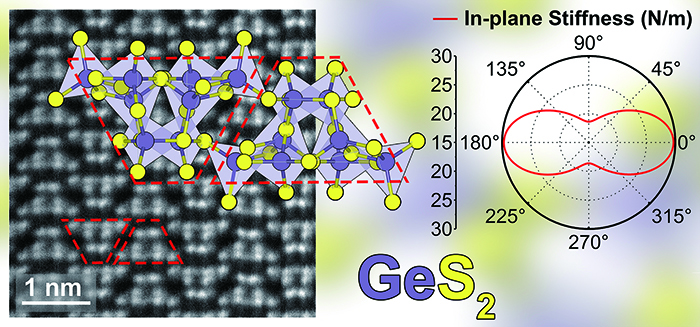Materials with layered crystal structures and high in-plane anisotropy, such as black phosphorus, present unique properties and thus promise for applications in electronic and photonic devices. Recently, the layered structures of GeS2 and GeSe2 were utilized for high-performance polarization-sensitive photodetection in the short wavelength region due to their high in-plane optical anisotropy and wide band gap. The highly complex, low-symmetric (monoclinic) crystal structures are at the origin of the high in-plane optical anisotropy, but the structural nature of the corresponding nanostructures remains to be fully understood.

To get further understanding of the origin of the complex anisotropic structure, Professor Wei Zhang’s group present an atomic scale characterization of monoclinic GeS2 nanostructures and quantify the in-plane structural anisotropy at the sub-Angstrom level in real space by Cs-corrected scanning transmission electron microscopy. The origin of this high in-plane anisotropy in terms of ordered and disordered arrangement of [GeS4] tetrahedra in GeS2 monolayers was elucidated through density functional theory (DFT) calculations and orbital-based bonding analyses and turned out to be the stabilization of chemical bonds upon tilting of the corner-shared GeS4 tetrahedra along the x-axis in the compact segment of the m-GeS2 monolayer.
High in-plane mechanical, electronic and optical anisotropies in monolayer GeS2 were also demonstrated in details, based on which a structural transition accompanied by a drastic change in optical and electrical properties was predicted to occur under uniaxial strain due to the small in-plane stiffness of m-GeS2. The tunable electronic structure and optical absorbance may render 2D GeS2 a potential candidate for electronic and optical memory on flexible substrates, enriching the established family of group IV chalcogenides (predominantly, tellurides) that currently employs amorphous-crystalline transitions for memory and photonics applications. Moreover, this work would also inspire more explorations of complex 2D materials with intriguing properties such as high anisotropy and porousness which cannot be found in simple structured materials.
These results were published on the journal ACS Nano titled as “Sub-Angstrom Characterization of the Structural Origin for High In-plane Anisotropy in 2D GeS2” (DOI: 10.1021/acsnano.9b10057). The co-first authors of this work include PhD students Xudong Wang, Jieling Tan and master student Chengqian Han from CAMPNano, XJTU. Prof. Wei Zhang (XJTU), Dr. Jiangjing Wang (XJTU) and Prof. Volker L. Deringer (Oxford University) are the co-corresponding authors. Prof. Chunlin Jia, Dr. Hongchu Du, Dr. Lu Lu and Prof. Jian Zhou also made important contributions to this work. The project was funded by National Natural Science Foundation of China (61774123) and 111 Project 2.0 (BP2018008).
Link: https://doi.org/10.1021/acsnano.9b10057


